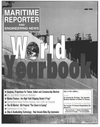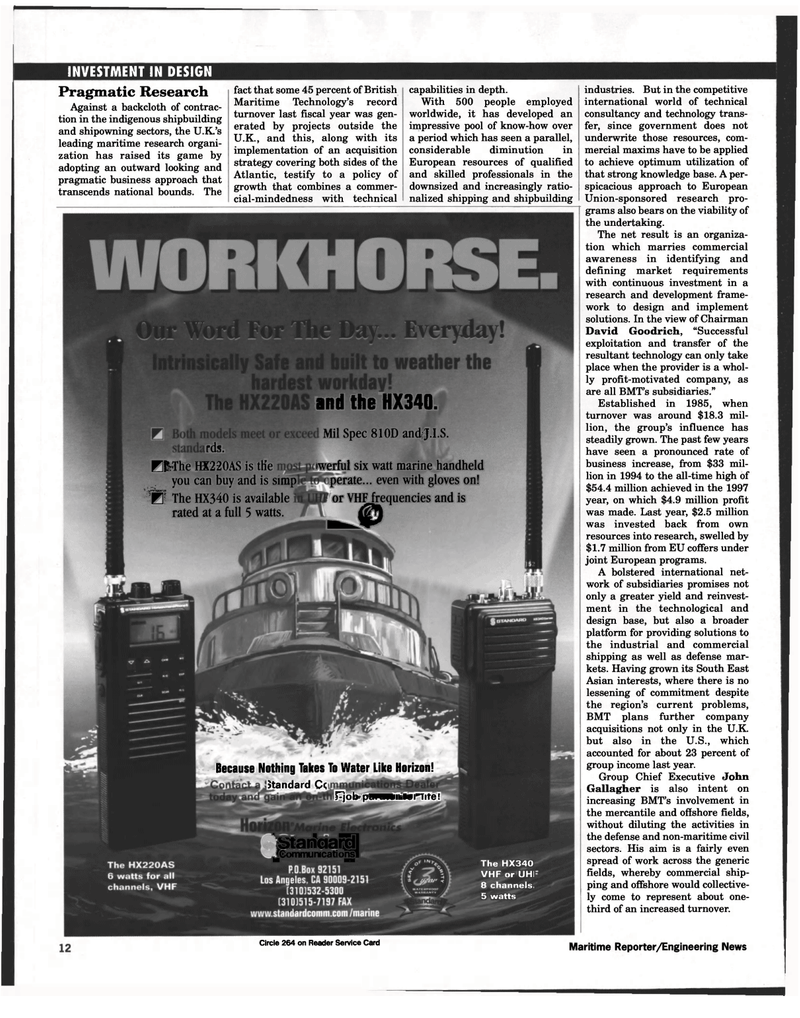
Page 12: of Maritime Reporter Magazine (June 1998)
Read this page in Pdf, Flash or Html5 edition of June 1998 Maritime Reporter Magazine
INVESTMENT IN DESIGN rds.
E The HX220AS is the you can buy and is
Spf The HX340 is available rated at a full 5 watts. simp and the HX340.
Mil Spec 810D and J.I.S. hverful six watt marine handheld perate... even with gloves on! or VHF frequencies and is
HP
Because Nothing Takes To Water Like Horizon!
Standard C< rjob pilW»Wll »4JI Tite! ipatjigaB JCommuracatio^l
The H X340
VHF o •r UHI 8 chai tinels. 5 watts
Pragmatic Research
Against a backcloth of contrac- tion in the indigenous shipbuilding and shipowning sectors, the U.K's leading maritime research organi- zation has raised its game by adopting an outward looking and pragmatic business approach that transcends national bounds. The fact that some 45 percent of British
Maritime Technology's record turnover last fiscal year was gen- erated by projects outside the
U.K., and this, along with its implementation of an acquisition strategy covering both sides of the
Atlantic, testify to a policy of growth that combines a commer- cial-mindedness with technical
Circle 264 on Reader Service Card Maritime Reporter/Engineering News capabilities in depth.
With 500 people employed worldwide, it has developed an impressive pool of know-how over a period which has seen a parallel, considerable diminution in
European resources of qualified and skilled professionals in the downsized and increasingly ratio- nalized shipping and shipbuilding industries. But in the competitive international world of technical consultancy and technology trans- fer, since government does not underwrite those resources, com- mercial maxims have to be applied to achieve optimum utilization of that strong knowledge base. A per- spicacious approach to European
Union-sponsored research pro- grams also bears on the viability of the undertaking.
The net result is an organiza- tion which marries commercial awareness in identifying and defining market requirements with continuous investment in a research and development frame- work to design and implement solutions. In the view of Chairman
David Goodrich, "Successful exploitation and transfer of the resultant technology can only take place when the provider is a whol- ly profit-motivated company, as are all BMT's subsidiaries."
Established in 1985, when turnover was around $18.3 mil- lion, the group's influence has steadily grown. The past few years have seen a pronounced rate of business increase, from $33 mil- lion in 1994 to the all-time high of $54.4 million achieved in the 1997 year, on which $4.9 million profit was made. Last year, $2.5 million was invested back from own resources into research, swelled by $1.7 million from EU coffers under joint European programs.
A bolstered international net- work of subsidiaries promises not only a greater yield and reinvest- ment in the technological and design base, but also a broader platform for providing solutions to the industrial and commercial shipping as well as defense mar- kets. Having grown its South East
Asian interests, where there is no lessening of commitment despite the region's current problems,
BMT plans further company acquisitions not only in the U.K. but also in the U.S., which accounted for about 23 percent of group income last year.
Group Chief Executive John
Gallagher is also intent on increasing BMT's involvement in the mercantile and offshore fields, without diluting the activities in the defense and non-maritime civil sectors. His aim is a fairly even spread of work across the generic fields, whereby commercial ship- ping and offshore would collective- ly come to represent about one- third of an increased turnover.

 11
11

 13
13
